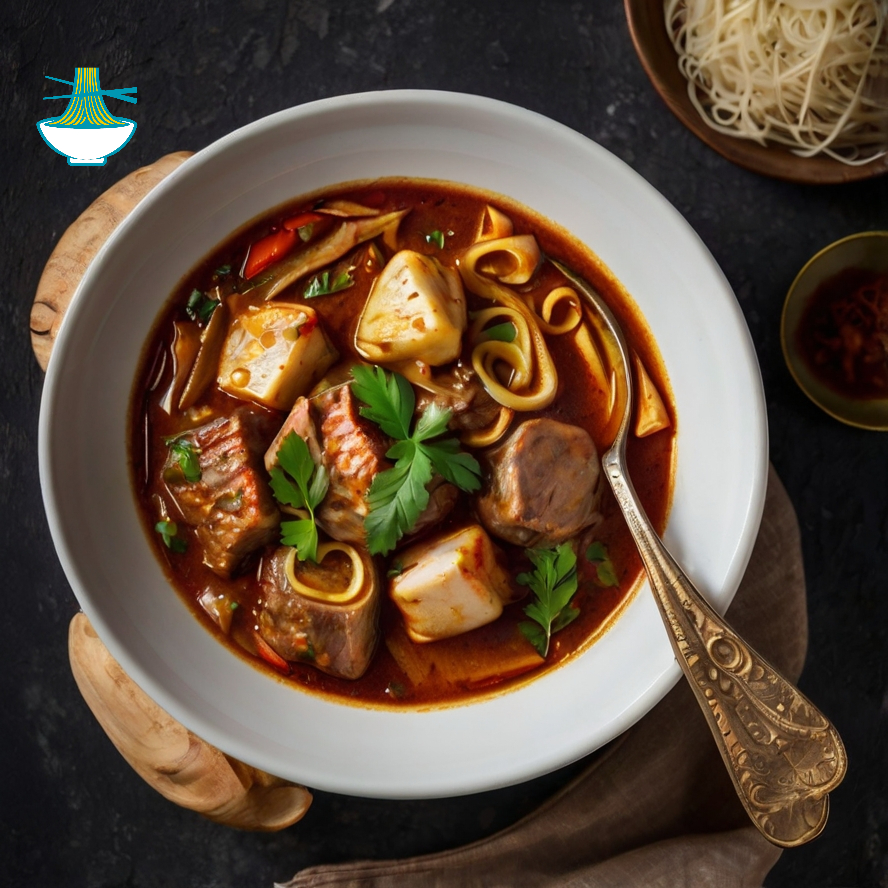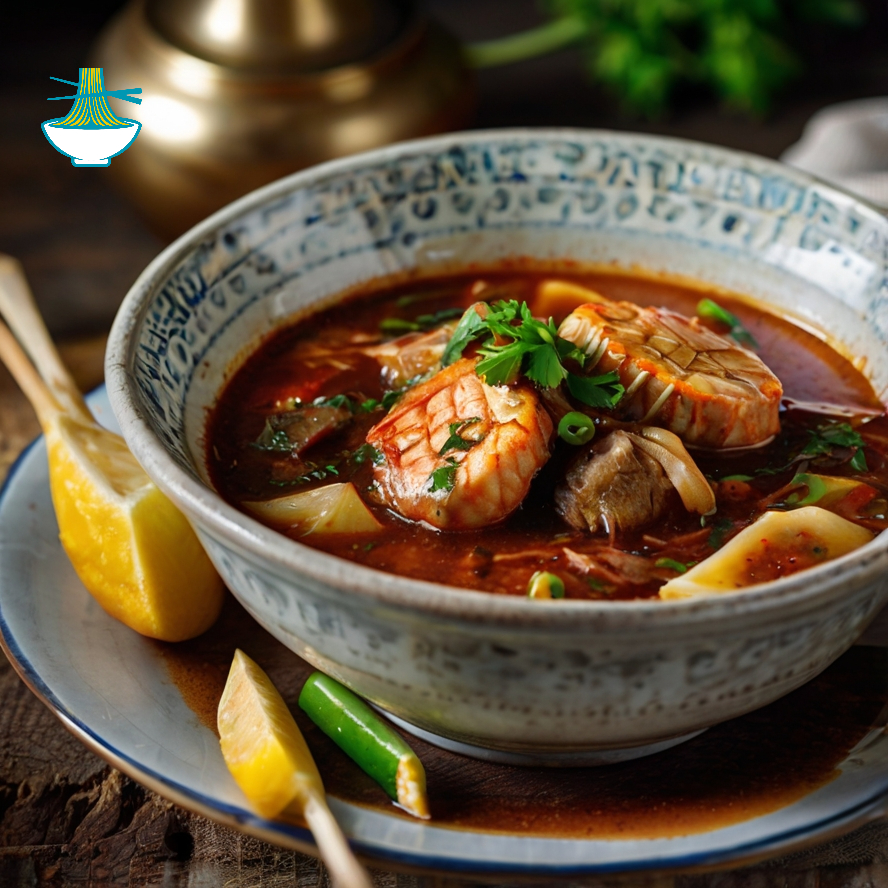Kholbo stew is a flavorful dish originating from Asian cuisine, typically made with either fish or meat combined with noodles. This hearty stew boasts a rich history, with variations found across different cultures and regions. Traditionally, it was prepared as a nourishing meal for families, often incorporating locally available ingredients and spices. Over time, Kholbo stew has evolved, adapting to diverse culinary preferences while retaining its essence of comfort and satisfaction. Whether enjoyed as a beloved family recipe or discovered as a culinary delight, Kholbo stew continues to captivate taste buds around the world with its enticing flavors and cultural significance.
Ingredients:
- 500g fish fillets or meat (such as chicken or beef), cut into bite-sized pieces
- 200g noodles (rice noodles or egg noodles work well)
- 1 onion, finely chopped
- 2 garlic cloves, minced
- 1-inch piece of ginger, grated
- 2 tomatoes, diced
- 1 bell pepper, sliced
- 2 tablespoons vegetable oil
- 4 cups water or broth
- Salt and pepper to taste
- Optional: chopped cilantro or green onions for garnish
Method:
1. Heat vegetable oil in a large pot over medium heat. Add chopped onion, minced garlic, and grated ginger. Sauté until fragrant and onions are translucent.
2. Add diced tomatoes and sliced bell pepper to the pot. Cook for another 3-4 minutes until the vegetables begin to soften.
3. Add fish fillets or meat pieces to the pot. Season with salt and pepper to taste. Cook until the meat is browned or fish is cooked through.
4. Pour water or broth into the pot and bring to a simmer. Allow the stew to cook for 15-20 minutes, allowing the flavors to meld together.
5. While the stew simmers, cook the noodles according to package instructions until al dente. Drain and set aside.
6. Once the stew is ready, adjust seasoning if necessary. Serve the stew hot over cooked noodles.
7. Garnish with chopped cilantro or green onions if desired. Enjoy your delicious Kholbo stew!
This clear and straightforward recipe should be easy to follow and accessible for anyone looking to prepare Kholbo stew at home.
Nutrition Value:
1. Fish Fillets or Meat (500g):
- Calories: Varies depending on the type of fish or meat used, approximately 150-250 calories per 100g.
- Carbohydrates: Negligible.
- Protein: Rich source, approximately 20-30g per 100g.
- Fat: Varies based on the type of fish or meat, generally lean.
- Sodium: Depends on preparation, generally low unless seasoned heavily.
- Cholesterol: Varies depending on the type of meat, generally moderate.
- Vitamins: Rich in B vitamins (B12, niacin, B6) and minerals like iron and zinc.
- Minerals: Contains essential minerals like iron, zinc, and phosphorus.
- Nutritional Benefit: High-quality protein source, essential for muscle repair and growth. Provides essential amino acids, vitamins, and minerals necessary for overall health.
2. Noodles (200g):
- Calories: Approximately 150-200 calories per 100g.
- Carbohydrates: High, around 25-30g per 100g.
- Protein: Moderate, about 3-5g per 100g.
- Fat: Low, typically less than 1g per 100g.
- Sodium: Varies depending on preparation, can be moderate.
- Cholesterol: Negligible.
- Vitamins: Some B vitamins like thiamine and niacin.
- Minerals: Contains small amounts of minerals like iron and calcium.
- Nutritional Benefit: Mainly a source of carbohydrates for energy. Provides some B vitamins and minerals.
3. Onion (1 onion):
- Calories: Approximately 40-50 calories per medium-sized onion.
- Carbohydrates: Moderate, around 10-12g per onion.
- Protein: Low, about 1g per onion.
- Fat: Negligible.
- Sodium: Low.
- Cholesterol: Negligible.
- Vitamins: Rich in vitamin C and B6.
- Minerals: Contains potassium and small amounts of other minerals.
- Nutritional Benefit: Provides antioxidants, vitamins, and minerals. Also adds flavor to the dish.
4. Garlic (2 cloves):
- Calories: Approximately 5-10 calories per clove.
- Carbohydrates: Low, around 1-2g per clove.
- Protein: Negligible.
- Fat: Negligible.
- Sodium: Negligible.
- Cholesterol: Negligible.
- Vitamins: Contains vitamin C and B6.
- Minerals: Small amounts of calcium, potassium, and phosphorus.
- Nutritional Benefit: Rich in antioxidants, may have various health benefits including boosting immune function.
5. Ginger (1-inch piece):
- Calories: Approximately 5-10 calories per inch piece.
- Carbohydrates: Low, around 1-2g per inch piece.
- Protein: Negligible.
- Fat: Negligible.
- Sodium: Negligible.
- Cholesterol: Negligible.
- Vitamins: Contains vitamin C and B6.
- Minerals: Small amounts of potassium and magnesium.
- Nutritional Benefit: Known for its anti-inflammatory properties, aids in digestion, and adds flavor to dishes.
6. Tomatoes (2 tomatoes):
- Calories: Approximately 15-20 calories per tomato.
- Carbohydrates: Low, around 3-5g per tomato.
- Protein: Low, about 1-2g per tomato.
- Fat: Negligible.
- Sodium: Low.
- Cholesterol: Negligible.
- Vitamins: Excellent source of vitamin C and vitamin A.
- Minerals: Contains potassium and small amounts of other minerals.
- Nutritional Benefit: Rich in antioxidants, vitamins, and minerals. Supports heart health and may reduce the risk of certain diseases.
7. Bell Pepper (1 bell pepper):
- Calories: Approximately 20-30 calories per bell pepper.
- Carbohydrates: Low, around 4-6g per bell pepper.
- Protein: Low, about 1g per bell pepper.
- Fat: Negligible.
- Sodium: Low.
- Cholesterol: Negligible.
- Vitamins: Excellent source of vitamin C and vitamin A.
- Minerals: Contains potassium and small amounts of other minerals.
- Nutritional Benefit: Provides antioxidants, vitamins, and minerals. Supports eye health and immune function.
8. Vegetable Oil (2 tablespoons):
- Calories: Approximately 120-240 calories per tablespoon (depends on the type of oil).
- Carbohydrates: Negligible.
- Protein: Negligible.
- Fat: High, primarily consisting of unsaturated fats.
- Sodium: Negligible.
- Cholesterol: Negligible.
- Vitamins: May contain vitamin E (if it's from a plant source like olive oil).
- Minerals: Negligible.
- Nutritional Benefit: Provides essential fatty acids and helps absorb fat-soluble vitamins.
9. Water or Broth (4 cups):
- Calories: Negligible.
- Carbohydrates: Negligible.
- Protein: Negligible.
- Fat: Negligible.
- Sodium: Depends on the type and amount used, can be moderate.
- Cholesterol: Negligible.
- Vitamins: Depends on the ingredients used to make the broth.
- Minerals: Depends on the ingredients used to make the broth.
- Nutritional Benefit: Hydrating and helps in cooking the dish. Broth may add flavor and nutrients.
10. Salt and Pepper (to taste):
- Calories: Negligible.
- Carbohydrates: Negligible.
- Protein: Negligible.
- Fat: Negligible.
- Sodium: High in salt.
- Cholesterol: Negligible.
- Vitamins: Negligible.
- Minerals: Negligible.
- Nutritional Benefit: Enhances flavor, but excessive consumption of salt may increase blood pressure.
11. Optional: Cilantro or Green Onions (for garnish):
- Calories: Negligible.
- Carbohydrates: Negligible.
- Protein: Negligible.
- Fat: Negligible.
- Sodium: Negligible.
- Cholesterol: Negligible.
- Vitamins: Contains vitamin K, vitamin C, and some B vitamins.
- Minerals: Contains small amounts of calcium, potassium, and magnesium.
- Nutritional Benefit: Adds freshness and flavor. Cilantro is rich in antioxidants and may have detoxifying properties, while green onions provide vitamins and minerals.


Comments